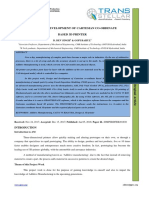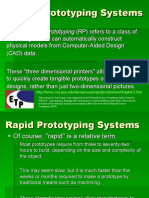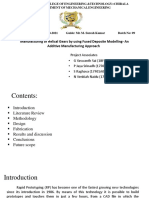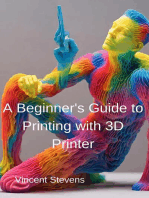Rapid Prototyping
Rapid Prototyping
Uploaded by
abhitanshusoniCopyright:
Available Formats
Rapid Prototyping
Rapid Prototyping
Uploaded by
abhitanshusoniCopyright
Available Formats
Share this document
Did you find this document useful?
Is this content inappropriate?
Copyright:
Available Formats
Rapid Prototyping
Rapid Prototyping
Uploaded by
abhitanshusoniCopyright:
Available Formats
Rapid prototyping R
Rapid prototyping is to computer-aided design (CAD) what the conventional
printer is to a word processor. It outputs representative physical parts
directly from CAD design files.
Safety
Environment
Life on board
Mobility
RENAULT COMMUNICATION
Competitiveness
BASIC FACTS in short
Producing a prototype always the ideal solution. Even This is where rapid prototyping Rapid prototyping
by traditional methods, if computer-assisted design (CAD) comes in. Thanks to its “3D printers” makes use of digital files
like sheet metal stamping, tools can deliver excellent results, it is it can ensure delivery in two to five
containing CAD virtual
metal part die-casting, or plastic important to be sure that no problem days of parts like door trims, and in
injection can take several months. is likely to arise in final assembly. two weeks of more complex pieces design data.
However, determining the tools for The only solution is therefore like dashboards, that need finishing They enable 3D real-life
manufacturing a car begins to produce a physical part from and assembly. Each part can then parts to be produced
a long way upstream from the actual digitized CAD files. Similarly, true be finally approved and the tools in just a few days, instead
production process and development judgements can be formed only from required to make them engineered. of the several weeks
lead times are growing shorter. actual parts like a dashboards or
necessary in traditional
Traditional protoyping is thus not handles in their real-life environment.
prototyping.
HOW DOES IT WORK?
Digital milling and hot plastics to those of the definitive part. parts become brittle and distorted.
are still widely used for rapid It is even possible to make flexible This downside restricts the use of
prototyping. However an approach or elastic parts by adding specially stereolithograpy for components
that is developing fast is for treated powder. Radiator hoses, requiring multiple assembly and
a machine to use a laser to for example, can be fabricated in disassembly on a prototype.
fabricate a part from a digital CAD this way. The powder can contain
file, outputting the data to a 3D powdered glass to make it stiffer Fused deposition modelling
printer, which builds an actual, and more heat-resistant, which can (FDM) is the only one of these
physical part. There are three be useful for parts in the vicinity new techniques not to use laser.
different fabrication techniques: of the engine block. The only A nozzle extrudes filaments
sintering, stereolithography, drawback of sintering is the of hot, melted ABS polymers
and fused deposition modelling. roughness of the surface or polycarbonates. The movements
Each method has particularities of the fabricated parts. of the nozzle are determined by CAD
which make it more less suited They require considerable manual software. A part takes shape as it is
to fabricating specific items finishing work before their built up from layers of melted plastic
according to the required design can be fully assessed. that harden immediately. The main
mechanical or visual properties. advantage of the technique is that
Stereolithography involves it uses the same material as the
Sintering involves the fusing, solidifying a liquid resin contained definitive part, so can be used
or polymerization, of powder in a vat by tracing a laser beam to validate bonded or thermowelded
materials, including polymers on its surface. A part is fabricated parts. The downside is that parts are
(plastic). The fusing is carried out by layer by layer, with the laser beam very porous because imperfections
a laser which moves by scanning tracing shapes from data in CAD form between each pass of the
cross-sections from CAD files, files. Stereolithography is the most nozzle. What’s more ABS polymers
building the part layer by layer. commonly used prototyping typing are sensitive to heat and are not
This method is particularly wellsuited technique. It is particularly well resistant to high temperatures.
to fabricating parts, like dashboard, adapted to making small items like FDM should not therefore be
that are likely to be assembled buttons, handles, and vent grills. used to make parts exposed to
and disassembled during testing. Its main drawback is that parts high temperatures, like those in
The mechanical properties of the are sensitive to ultraviolet rays. the vicinity of the engine block.
sintered part – how flexible Daylight and sun rays impair their
or stiff it is – are relatively similar mechanical properties. Gradually
December 2008
You might also like
- Park - Fundamentals of Engineering Economics, 2nd Edition - Solution Manual - ch0Document4 pagesPark - Fundamentals of Engineering Economics, 2nd Edition - Solution Manual - ch0Martin Van Nostrand0% (11)
- Additive Manufacturing - Question Bank With Answers - May 2023Document13 pagesAdditive Manufacturing - Question Bank With Answers - May 2023Surya100% (4)
- Module-1 Additive Manufacturing 18 SchemeDocument47 pagesModule-1 Additive Manufacturing 18 SchemeSANTOSH100% (1)
- 07 Final Rapid Prototype ReportDocument16 pages07 Final Rapid Prototype ReportpallaviNo ratings yet
- Master of Sustainable Engineering in ProductionDocument70 pagesMaster of Sustainable Engineering in ProductionBasheer W. ShaheenNo ratings yet
- MSU6 Rapidprototypingtask 2Document27 pagesMSU6 Rapidprototypingtask 2Navaneeth Satyanarayana MurthyNo ratings yet
- 3 D Printing TechnologyDocument17 pages3 D Printing TechnologyClassic PrintersNo ratings yet
- Cim ReportDocument7 pagesCim Reportsrujangowdasj2002No ratings yet
- 3d Printing For Manufacture A Basic Design Guide Download OriginalDocument26 pages3d Printing For Manufacture A Basic Design Guide Download OriginalritamendesNo ratings yet
- 3D Printing in Prosthodontics: Additive Manufacturing TechnologyDocument6 pages3D Printing in Prosthodontics: Additive Manufacturing TechnologyRiya KvNo ratings yet
- RP Technologies-AAE 2272 (2022) - 1Document39 pagesRP Technologies-AAE 2272 (2022) - 1Mohammed ZubairNo ratings yet
- Design and Development of Cartesian Co-Ordinate Based 3D PrinterDocument8 pagesDesign and Development of Cartesian Co-Ordinate Based 3D PrinterTJPRC PublicationsNo ratings yet
- MSU6 Rapidprototypingtask 2Document27 pagesMSU6 Rapidprototypingtask 2adinamdarNo ratings yet
- SeminarDocument19 pagesSeminarSharath Kumar100% (1)
- Department of Mechanical EnginneringDocument11 pagesDepartment of Mechanical EnginneringViraj SukaleNo ratings yet
- Unit - 1 IntroductionDocument26 pagesUnit - 1 IntroductionAbinaya VarmaNo ratings yet
- Metal 3D PrintingDocument2 pagesMetal 3D Printingmahesh DhokaNo ratings yet
- Module - 1: Regulation - 2015 (CBCS Scheme) Additive Manufacturing - 15me82Document37 pagesModule - 1: Regulation - 2015 (CBCS Scheme) Additive Manufacturing - 15me82swaroop kenganalNo ratings yet
- Rapidprototyping 170316110503 PDFDocument66 pagesRapidprototyping 170316110503 PDFDeepthi GangadharNo ratings yet
- Rapid PrototypingDocument82 pagesRapid Prototypingts619469No ratings yet
- Irjet V7i2660Document3 pagesIrjet V7i2660vsraju2No ratings yet
- TO Rapid Prototyping (RP) : Prepared By: Dr. Chirag R. SanghaniDocument11 pagesTO Rapid Prototyping (RP) : Prepared By: Dr. Chirag R. SanghanichiragcaeNo ratings yet
- Additive Manufacturing Module 1Document47 pagesAdditive Manufacturing Module 1sneakerspark07No ratings yet
- 1620isie9720-20rap ProtDocument6 pages1620isie9720-20rap ProtlonerdropNo ratings yet
- Mini Project SynopsysDocument6 pagesMini Project SynopsysViraj SukaleNo ratings yet
- AM Presentation Group 2Document12 pagesAM Presentation Group 2gudducelloNo ratings yet
- Sciencedirect: Additive Manufacturing of Fixture For Automated 3D Scanning - Case StudyDocument6 pagesSciencedirect: Additive Manufacturing of Fixture For Automated 3D Scanning - Case StudyraharjoNo ratings yet
- Presented By: Anil Varghese Mangalan Design and Manufacturing Dept of Mechanical Engg Nit SilcharDocument17 pagesPresented By: Anil Varghese Mangalan Design and Manufacturing Dept of Mechanical Engg Nit SilcharVikky HariNo ratings yet
- R P, T, F: Apid Rototyping Ooling AND AbricationDocument26 pagesR P, T, F: Apid Rototyping Ooling AND AbricationSreejith S NairNo ratings yet
- Thermo Fluid Analysis SoftwareDocument32 pagesThermo Fluid Analysis SoftwareWilly Thomas MrazNo ratings yet
- Rapid PrototypingDocument18 pagesRapid Prototypingrippervasu100% (3)
- Using 3D Printing Technology in Prototype ProductionDocument9 pagesUsing 3D Printing Technology in Prototype Productionxuyan yinNo ratings yet
- Chapter 1Document67 pagesChapter 1Thanes WaranNo ratings yet
- 3D Printing of Microwave and Millimeter-Wave Filters: 24 June 2020 1527-3342/20©2020IEEEDocument22 pages3D Printing of Microwave and Millimeter-Wave Filters: 24 June 2020 1527-3342/20©2020IEEEHüseyin Nuri GülmezNo ratings yet
- Chapter 3 UavDocument5 pagesChapter 3 Uavmazai5286No ratings yet
- Manufacturing of Helical Gears by Using Fused Deposite Modelling-An Additive Manufacturing ApproachDocument22 pagesManufacturing of Helical Gears by Using Fused Deposite Modelling-An Additive Manufacturing ApproachSri Nadh PadavalaNo ratings yet
- Simufact - Forming The Simulation Solution For Bulk Sheet Metal FormingDocument15 pagesSimufact - Forming The Simulation Solution For Bulk Sheet Metal FormingShashin VyasNo ratings yet
- Stereo Lithography PresentationDocument28 pagesStereo Lithography PresentationJayanth RajNo ratings yet
- Enhancing Precision Investment Casting Via 3D PrintingDocument16 pagesEnhancing Precision Investment Casting Via 3D Printingantracite.worktestNo ratings yet
- FDM 3D PrinterDocument23 pagesFDM 3D PrinterYuvraj MarneNo ratings yet
- Additive Fact SheetDocument2 pagesAdditive Fact SheetMustafaNo ratings yet
- Additive Manufacturing FinalDocument31 pagesAdditive Manufacturing FinalbetruckoumaNo ratings yet
- Rapid Prototyping / Additive Manufacturing / Rapid ManufacturingDocument202 pagesRapid Prototyping / Additive Manufacturing / Rapid ManufacturingDaily SerialsNo ratings yet
- C1 C Girum Tesfaye Gedecho 3D PrintingDocument5 pagesC1 C Girum Tesfaye Gedecho 3D PrintingGirum TesfayeNo ratings yet
- 3d Printing in Aerospace and Defense PDFDocument5 pages3d Printing in Aerospace and Defense PDFIskandar ZulkarnainNo ratings yet
- Rapid Prototyping: Introduction To RPDocument72 pagesRapid Prototyping: Introduction To RPHari HaranNo ratings yet
- Para 4Document10 pagesPara 4Anh HàNo ratings yet
- 3D PrintingDocument16 pages3D Printingsagar_sgrNo ratings yet
- Rapid Prototyping: Kubersuryavanshi BT16MEC004 Nationalinstitute of TechnologyuttarakhandDocument26 pagesRapid Prototyping: Kubersuryavanshi BT16MEC004 Nationalinstitute of TechnologyuttarakhandShubham ChomalNo ratings yet
- Seminar Report On "Additive Manufacturing"Document44 pagesSeminar Report On "Additive Manufacturing"Zeel PatelNo ratings yet
- A Review of AM in Aerospace ApplicationDocument7 pagesA Review of AM in Aerospace ApplicationGiank MarchNo ratings yet
- Paper On: IndexDocument4 pagesPaper On: Indexamar_bhupali1507No ratings yet
- Alex Do MSthesis PDFDocument18 pagesAlex Do MSthesis PDFgajaramilloNo ratings yet
- 3D Printing: By: Bhumika MaroliaDocument23 pages3D Printing: By: Bhumika MarolianavaneethNo ratings yet
- Fused Deposition Modeling (FDM) : How Is The FDM Part Built?Document2 pagesFused Deposition Modeling (FDM) : How Is The FDM Part Built?Zaheer AhamedNo ratings yet
- CSE 3D Printing ReportDocument18 pagesCSE 3D Printing ReportAksh RawalNo ratings yet
- 3 DPDocument44 pages3 DPPooja AngolkarNo ratings yet
- Product Brochure: Multiphysics Computational Fluid Dynamics SolutionDocument32 pagesProduct Brochure: Multiphysics Computational Fluid Dynamics SolutionHoang MaiNo ratings yet
- Direct Digital ManufacturingDocument10 pagesDirect Digital ManufacturingMohammed HabeebNo ratings yet
- Additive Manufacturing Technology: The Status, Applications, and ProspectsDocument15 pagesAdditive Manufacturing Technology: The Status, Applications, and ProspectsImrul Kayes KhanNo ratings yet
- Uniform Manufacturer in QatarDocument5 pagesUniform Manufacturer in QatarHouse of UniformsNo ratings yet
- Unilever's Perfect Village InitiativeDocument8 pagesUnilever's Perfect Village InitiativeabyNo ratings yet
- Auto GPT - Simplified TranscriptDocument9 pagesAuto GPT - Simplified Transcriptjake.cromptonNo ratings yet
- Principles of Macroeconomics Chapter 4: Prices-Free, Controlled, and Relative Practice Problems (Answers Given Below)Document2 pagesPrinciples of Macroeconomics Chapter 4: Prices-Free, Controlled, and Relative Practice Problems (Answers Given Below)bamonNo ratings yet
- Supplier Subcontractor: Ac Stomer A Consultant ADocument2 pagesSupplier Subcontractor: Ac Stomer A Consultant AПавел ИванниковNo ratings yet
- CHAPTER 6 - Development Budget and AppraisalsDocument14 pagesCHAPTER 6 - Development Budget and Appraisalsnaurahiman100% (1)
- Abm Script: (Scenario 1 - Meeting)Document7 pagesAbm Script: (Scenario 1 - Meeting)Ethel Mary LozadaNo ratings yet
- Mintainanace Task List in SAP PM & Its Usage in Maintenance OrderDocument17 pagesMintainanace Task List in SAP PM & Its Usage in Maintenance OrderHala TAMIMENo ratings yet
- Wages & Benefits Record Business License: Date of Audit: Audit Type: Unit Name: VendorDocument1 pageWages & Benefits Record Business License: Date of Audit: Audit Type: Unit Name: VendorImran KhanNo ratings yet
- Sales DepartmentDocument30 pagesSales DepartmentJandrei Ezekiel LausNo ratings yet
- HLL Life Care Limited 1576048010Document3 pagesHLL Life Care Limited 1576048010Rama JanNo ratings yet
- Change Management in Icici BankDocument18 pagesChange Management in Icici BankSagar SharmaNo ratings yet
- Engineering Economics: By: Maher Falih Hussein Msc. in Petroleum Engineering Assistant Chief Engineer Boc / ZfodDocument13 pagesEngineering Economics: By: Maher Falih Hussein Msc. in Petroleum Engineering Assistant Chief Engineer Boc / Zfodali rizaNo ratings yet
- 699-12 Commercial Building (3B+G+M+9) : Method Statement For Installation of Fire Suppression SystemDocument8 pages699-12 Commercial Building (3B+G+M+9) : Method Statement For Installation of Fire Suppression Systemashiq rahimNo ratings yet
- Por Qué Estudiar en El ExtranjeroDocument8 pagesPor Qué Estudiar en El Extranjeroafefhvaue100% (1)
- BM Study Guide HLDocument70 pagesBM Study Guide HLKirsten Dell GayataoNo ratings yet
- COPY Not Negotiable: by Maersk Brasil (Brasmar) Ltda HERNANDO F. SANTOS - CPF. 329.606.418-41Document2 pagesCOPY Not Negotiable: by Maersk Brasil (Brasmar) Ltda HERNANDO F. SANTOS - CPF. 329.606.418-41Fernando GariaNo ratings yet
- Session 7 MH - Return and Risk - Exercises - SolutionsDocument10 pagesSession 7 MH - Return and Risk - Exercises - SolutionsPN VoviNo ratings yet
- Consulting FrameworksDocument10 pagesConsulting Frameworkskhushi bansalNo ratings yet
- CIR V Mirant Pagbilao CorporationDocument11 pagesCIR V Mirant Pagbilao CorporationMA. TERIZ S CASTRONo ratings yet
- Retail Job ResumeDocument7 pagesRetail Job Resumegt6rjvnc100% (1)
- General Director AdDocument1 pageGeneral Director Adapi-690640369No ratings yet
- Employment ContractDocument4 pagesEmployment ContractRamesh Kumar a/l Moona Haji Mohamed RajooNo ratings yet
- Screenshot 2023-10-02 at 3.41.33 PMDocument3 pagesScreenshot 2023-10-02 at 3.41.33 PMNareen RajNo ratings yet
- Cepm T1 T2Document13 pagesCepm T1 T2Gwyneth Lynn C. InchanNo ratings yet
- Google Analytics: Setup GuideDocument25 pagesGoogle Analytics: Setup Guideednan_arifNo ratings yet
- Blood Bank Management SystemDocument4 pagesBlood Bank Management SystemIJARSCT JournalNo ratings yet
- UntitledDocument5 pagesUntitledKrizia CruzNo ratings yet
- 74719bos60485 Inter p1 cp13Document92 pages74719bos60485 Inter p1 cp13Aniruddh SoniNo ratings yet

























































































